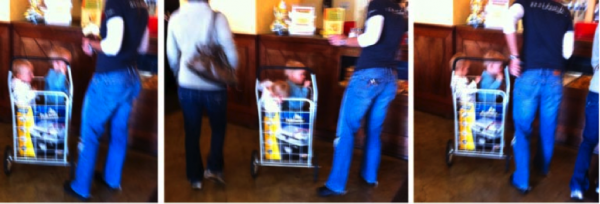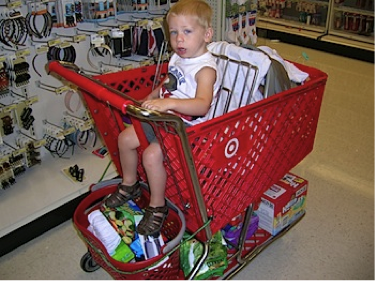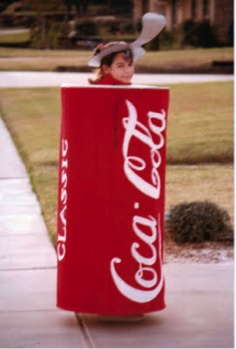The Tension between Convention and Innovation: Reflections on Toddlers in Foldable Shopping Carts
December 10, 2012
PROJECTS: Leveling Up
TAGS: Connected Learning, Convention, Design, Innovation
This is the first of a series of posts that I will write exploring the tensions between innovation and convention, and what it means for the design of Connected Learning Environments. This first post focuses on the lure of convention, and why it is so much easier to go with the status quo, than to forge your own path.

Sorry for the blurriness, but I had to take the photos rather quickly while pretending to work on my dissertation. The scene above occurred at one of my favorite coffee shops. One day a woman strolled in with a cart packed full of children and merchandise. She then transported her cargo to the front of the counter where she casually ordered coffee and some baked goods. This scene astounded me. I was both in awe of the cleverness of the cart’s appropriation and slightly taken aback by the unconventional confinement of the children. Although the makeshift stroller seemed safe, and accomplished the goal of moving multiple items simultaneously, I just could not shake the feeling of wrongness. I mean, the cart was not designed to contain children. Moreover, children are our future, so how could she put these destined heroes into a contraption made for Cheetos and toilet paper?
Looking back, I do not understand why I was so shocked. I have probably passed by tons of kids in shopping carts while browsing the aisles of Safeway, Costco, and Target. So why was this makeshift stroller so jarring?

Photo courtesy of: http://www.parenthacks.com/
Well, the easy and most responsible answer is that I was concerned for the welfare of the children, which is true. Several accidents have occurred involving children and standard grocery carts [1]. However, several accidents have occurred with children and swings [2] and I do not blink when I pass them in yards, parks, or school campuses. In all honesty, I think the true source of my discomfort with the makeshift stroller was its deviation from convention. The foldable cart was designed to hold consumer products. Children are not consumer products, and it seems slightly amiss to treat them in the same manner (although there are times that I think it is kind of cute).

Photo courtesy of: http://marcusanddina.blogspot.com/2009_10_01_archive.html
The makeshift stroller contradicted my implicit notions of the purpose of the cart, the transportation of children, and my conventional views of what activities are supposed to occur within a coffee shop. These notions made it hard for me to appreciate the innovative step the woman took to simultaneously satisfy her childcare and shopping needs.
I am an educational researcher investigating ways to improve students’ capabilities with technology, particularly their capabilities to innovate with and on technical devices. Thus, I spend a great deal of time thinking about why people do or do not innovate with technology. One reason why I believe more people do not innovate with technology is because it is hard to go against convention. I mean, it is so much easier just to use an existing app (even if it does not satisfy all of your needs), follow the recipe (even if the taste is just okay), or give a tip (even if your water never was refilled) than to create your own app, recipe, or ask for a different waiter. It takes less effort to follow the status quo. Moreover, by following convention, an individual minimizes his or her exposure to failure and to public censure. A makeshift stroller in a coffee shop was sufficient deviation from the norm for me to privately question a woman’s parenting skills.
Innovation is risky. So how do we create learning environments that prepare students to assess situations and take on the risks of innovation, especially in cases when educators may not agree with the direction of the innovation? In my next post, I will discuss this tension a little further by exploring the realm of hacking.
References
[1] DeFao, J. (2006, August 7). Doctors say carts can be a danger to children, Pediatricians blame design, urge parents not to put kids in them. The San Francisco Chronicle. Retrieved December 2, 2012, from http://www.sfgate.com/health/article/Doctors-say-carts-can-be-a-danger-to-children-2491679.php
[2] Safe Kids USA. Playground Safety Fact Sheet. Retrieved December 2, 2012, from http://www.safekids.org/our-work/research/fact-sheets/playground-safety-fact-sheet.html


